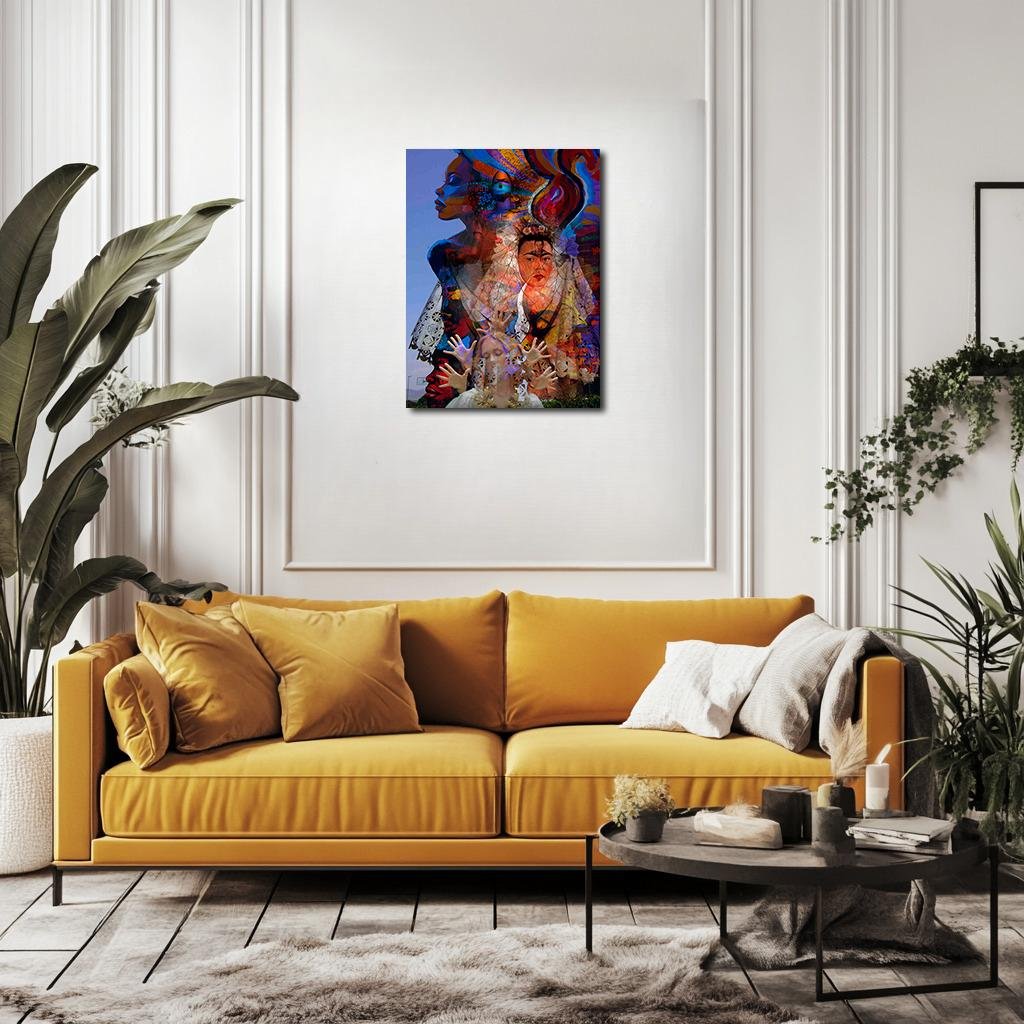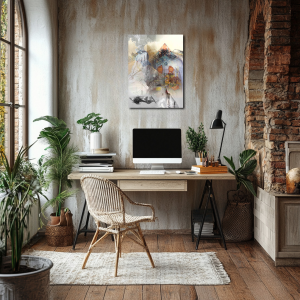Breath of Earth: Frida’s Resurrection Through Roots
Breath of Earth reimagines Frida Kahlo’s Roots as a mythic metamorphosis where her body merges with the cracked earth and the dreaming trees. In a landscape divided between barren blues and radiant golds, Frida’s spirit pulses through the roots, blossoms, and broken soil. Through molten reds, icy blues, luminous yellows, and twilight purples, the piece evokes suffering as the seed of transcendent endurance. Frida becomes not just a figure of pain, but the living, breathing soul of the earth itself.
Please see Below for Details…
Hotline Order:
Mon - Fri: 07AM - 06PM
404-872-4663
This conceptual reimagining of Frida Kahlo’s Roots unfolds the artist’s eternal bond with the earth, rendering her not merely a figure upon it, but a consciousness embedded within its very veins. Titled Breath of Earth , the piece expands upon Kahlo’s original vision of interconnectedness, deepening it into a mythic metamorphosis where Frida's broken body and the world’s endless cycles of life and decay dissolve into each other. Here, the artist is not just nurtured by the land—she becomes its dreaming spirit, its wounded yet breathing soul.
At the center of the composition lies Frida’s reclining form, draped in deep crimson cloth, her hair unfurled like tributaries of dark water. Her body cracks open into veins and tendrils, which plunge into the earth and blossom into sinuous, withering branches. The ground is a living membrane: fertile yet fractured, ancient yet feverishly alive. Frida's ribs seem to transform into root systems themselves, suggesting that her survival, her pain, and her creativity all spring from the same elemental soil.
Towering over this scene are two mythic trees: one barren and ghostly, its trunk a swirling lattice of ash and memory; the other radiant and golden, its branches aflame with new creation. Between them floats a spectral visage—Frida’s face reimagined as the cracked, ancient bark of a primordial tree. Her green eyes, impossibly alive within the stone texture of her face, gaze outward, holding the terrible wisdom of suffering that neither condemns nor forgives but simply endures.
The play of color across the piece is deeply symbolic, weaving emotional landscapes into the visual fabric. The foreground is dominated by a palette of warm, broken reds and burnt oranges, creating an atmosphere of sacrifice and renewal. The crimson of Frida’s gown bleeds into the soil, transforming into the orange veins and roots that fracture the ground. This merging suggests that her physical suffering and emotional endurance are nutrients feeding the next life cycle.
The left side of the composition is veiled in icy blue and misty whites, dominated by the lifeless, skeletal tree. These cold hues evoke numbness, abandonment, the frozen stasis that follows profound trauma. They suggest a world where vitality has ebbed away, where memory calcifies into brittle monuments. Yet even within these muted tones, there are whispers of green at the edges—a quiet insistence that rebirth is already germinating beneath the frost.
Conversely, the right side of the scene bursts into radiance: luminous yellows, fiery golds, and molten ambers flood the landscape, emanating from the life-tree’s effulgent crown. This palette does not signify naive happiness; rather, it expresses the brutal, necessary triumph of life insisting upon itself after devastation. It is the raw yellow of fierce sunlight, the gold of scorched survival, the ember that refuses to die out. This blaze of color suggests that from brokenness, brilliance can rise—not unscarred, but ablaze with a hard-won vitality.
Threaded through the sky, a dreamlike dusk unfolds—muted purples, fading cobalts, and soft bruises of pink. These transitions between day and night, life and death, pain and resurrection, hint that the world Kahlo inhabits is neither fixed nor purely symbolic; it is a living transition, a perpetual becoming. This twilight atmosphere wraps the image in a mythic, sacred silence, honoring the transformations that occur unseen, underground, within the hidden core of existence.
When I created Breath of Earth , I wanted to explore Frida’s original intent not simply as a statement of personal suffering, but as a universal myth of endurance through rootedness. Kahlo’s life was shaped by fractures—both in body and in destiny—yet she never portrayed herself as severed from life. Instead, she depicted herself always as grafted onto something larger, something ancient and cyclical. In this reimagining, I wanted her body to disappear into the very architecture of the earth, to become the dreaming eyes of the trees, the cracked roots, the heavy sky—proof that survival is not a return to wholeness, but a transformation into a new kind of existence.
The composition spirals organically from Frida’s body outward—first into the shattered earth, then climbing through the spectral trees, finally diffusing into the vast, breathing cosmos beyond. This movement suggests that pain does not contain or define the spirit, but becomes part of the endless story the spirit writes through matter and time. Frida is no longer a passive figure enduring pain; she is the spirit that rises through pain, reshaping the world she once suffered from.
Add your review
Your email address will not be published. Required fields are marked *
Please login to write review!
Looks like there are no reviews yet.








